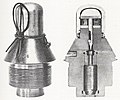Ficheiro:No106FuzeSectionPhoto.jpg

Dimensões desta antevisão: 712 × 600 píxeis. Outras resoluções: 285 × 240 píxeis | 570 × 480 píxeis.
Imagem numa resolução maior (800 × 674 píxeis, tamanho: 109 kB, tipo MIME: image/jpeg)
Histórico do ficheiro
Clique uma data e hora para ver o ficheiro tal como ele se encontrava nessa altura.
| Data e hora | Miniatura | Dimensões | Utilizador | Comentário | |
|---|---|---|---|---|---|
| atual | 06h12min de 5 de julho de 2008 |  | 800 × 674 (109 kB) | Rcbutcher | {{Information |Description= |Source= |Date= |Author= |Permission= |other_versions= }} |
| 10h48min de 29 de junho de 2008 |  | 640 × 534 (200 kB) | Rcbutcher | {{Information |Description=Photograph showing sectioned British No. 106 direct-action percussion fuze, World War I vintage. |Source=British ordnance manual circa. 1916-1918 |Date=circa. 1916-1918 |Author=War Office, UK |Permission=Crown copyright expired |
Utilização local do ficheiro
A seguinte página usa este ficheiro:
Utilização global do ficheiro
As seguintes wikis usam este ficheiro:
- da.wikipedia.org
- de.wikipedia.org
- en.wikipedia.org
- lt.wikipedia.org
- pl.wikipedia.org
- ru.wiktionary.org
- uk.wikipedia.org
- www.wikidata.org
